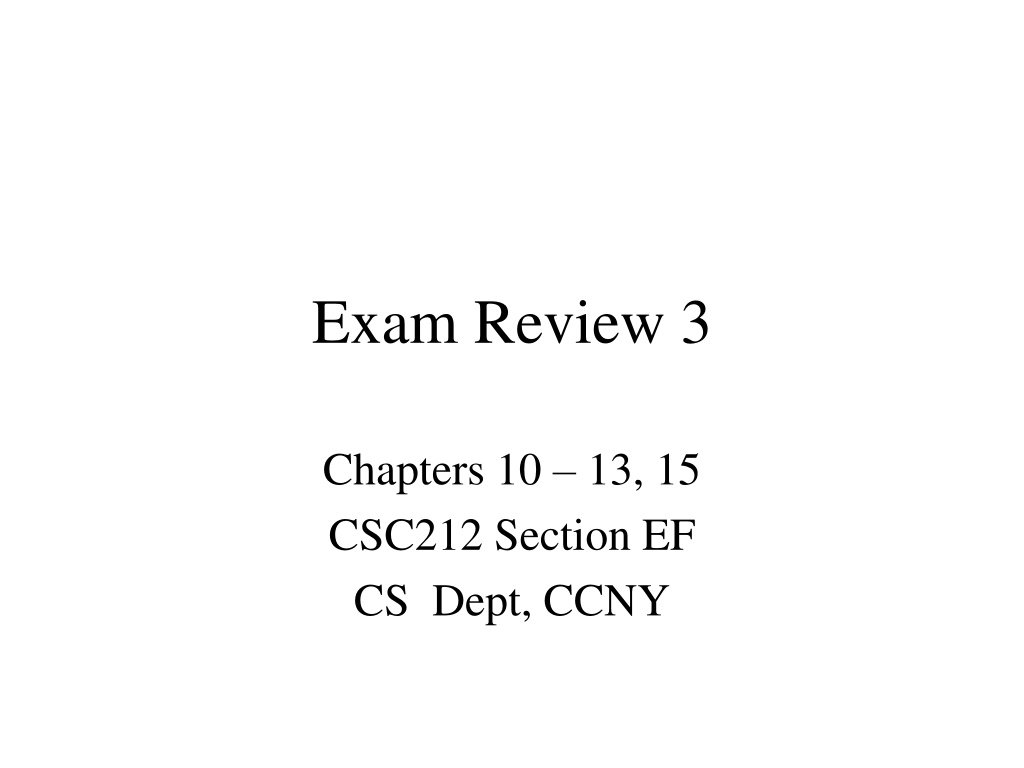
Advanced Data Structures and Algorithms Overview
Explore a comprehensive review of advanced data structures and algorithms, covering topics like binary search trees, heaps, B-trees, time analysis, and more. Enhance your understanding of tree structures, traversal methods, and their applications in different algorithms. Discover the complexities of implementing and analyzing these data structures, with a focus on efficiency and worst-case scenarios.
Download Presentation

Please find below an Image/Link to download the presentation.
The content on the website is provided AS IS for your information and personal use only. It may not be sold, licensed, or shared on other websites without obtaining consent from the author. If you encounter any issues during the download, it is possible that the publisher has removed the file from their server.
You are allowed to download the files provided on this website for personal or commercial use, subject to the condition that they are used lawfully. All files are the property of their respective owners.
The content on the website is provided AS IS for your information and personal use only. It may not be sold, licensed, or shared on other websites without obtaining consent from the author.
E N D
Presentation Transcript
Exam Review 3 Chapters 10 13, 15 CSC212 Section EF CS Dept, CCNY
First Course Survey! Exam Review 3 Chapters 10 13, 15 CSC212 Section EF CS Dept, CCNY
Trees and Traversals Tree, Binary Tree, Complete Binary Tree child, parent, sibling, root, leaf, ancestor,... Array Representation for a Complete Binary Tree Difficult if not complete binary tree A Class of binary_tree_node each node with two link fields Tree Traversals The recursive thinking makes things much easier A general Tree Traversal A Function as a parameter of another function
Binary Search Trees (BSTs) Binary search trees are a good implementation of data types such as sets, bags, and dictionaries. Searching for an item is generally quick since you move from the root to the item, without looking at many other items. Adding and deleting items is also quick. But as you'll see later, it is possible for the quickness to fail in some cases -- can you see why? ( unbalanced )
Heaps Heap Definition A complete binary tree with a nice property Heap Applications priority queues (chapter 8), sorting (chapter 13) Two Heap Operations add, remove reheapification upward and downward why is a heap good for implementing a priority queue? Heap Implementation using binary_tree_node class using fixed size or dynamic arrays
B-Trees A B-tree is a tree for sorting entries following the six rules B-Tree is balanced - every leaf in a B-tree has the same depth Adding, erasing and searching an item in a B-tree have worst-case time O(log n), where n is the number of entries However the implementation of adding and erasing an item in a B-tree is not a trivial task.
Trees - Time Analysis Big-O Notation : Order of an algorithm versus input size (n) Worse Case Times for Tree Operations O(d), d = depth of the tree Time Analysis for BSTs worst case: O(n) Time Analysis for Heaps worst case O(log n) Time Analysis for B-Trees worst case O(log n) Logarithms and Logarithmic Algorithms doubling the input only makes time increase a fixed number
Searching Applications Database, Internet, AI... Most Common Methods Serial Search O(n) Binary Search O(log n) Search by Hashing - O(k) Run-Time Analysis Average-time analysis Time analysis of recursive algorithms
Quadratic Sorting Both Selectionsort and Insertionsort have a worst- case time of O(n2), making them impractical for large arrays. But they are easy to program, easy to debug. Insertionsort also has good performance when the array is nearly sorted to begin with. But more sophisticated sorting algorithms are needed when good performance is needed in all cases for large arrays.
O(NlogN) Sorting Recursive Sorting Algorithms Divide and Conquer technique An O(NlogN) Heap Sorting Algorithm making use of the heap properties STL Sorting Functions C++ sort function Original C version of qsort
Graphs Examples/Applications Terminologies Representations Graph Traversal: DFS and BFS
void merge(int data[ ], size_t n1, size_t n2) // Precondition: The first n1 elements of data are sorted, and the // next n2 elements of data are sorted (from smallest to largest). // Postcondition: The n1+n2 elements of data are now completely // sorted.
//retrievals data left right //set set_data set_left set_right //boolean is_leaf Exam question example Using the binary_tree_node from page 481, write a recursive function to meet the following specification. Check as much of the precondition as possible. template <class Item> void flip(binary_tree_node<Item>* root_ptr) // Precondition: root_ptr is the root pointer of a non-empty binary tree. // Postcondition: The tree is now the mirror image of its original value. // Example original tree: Example new tree: // 1 1 // / \ / \ // 2 3 3 2 // / \ / \ // 4 5 5 4






















